Sony VTC5: Test results and proof we sell authentic Sony VTC5 batteries
Posted by Jonathan Caserta on
The Sony VTC5. The battery, the myth, the legend. So much misinformation out there on these right now. Is the VTC5 discontinued? Are there fake batteries out there that look just like originals? Are there legit sony vtc5 18650 batteries? Are the ones Liion Wholesale sells authentic vtc5's? Do they have VTC5 test results? Let's dig into it.
Background
The Sony VTC5 (official model number Sony US18650VTC5) is a 2600mAh cell 20A high drain 18650 battery, with a unique specification that sometimes allows usage to 30A. Sometimes it's labeled as the Sony VCT5 (or US18650VCT5). Some refer to it as a Konion cell. It has a great reputation particularly among hobbyists who need high mAh and high drain capabilities like e-bike builders, vaping users, and high powered light customers.
In mid-late 2014, these cells disappeared from the market. Since it was so popular, many fakes appeared. It was impossible to get a genuine VTC5 in late 2014 other than from one or two suppliers charging tons of money for very old stock.
But, a few months ago in the middle of 2015, supply appeared again for us. Since then we've gotten many questions about proving that they're legit genuine VTC5's. This article goes through a large chunk of our test report in order to do that.
Sony VTC5 Physical Inspection
Sony VTC5 measurements
Two samples were taken, each from different shipments. An inspection was done compared to the Sony VTC5 specification, found on Powerstream's site here. Two sample VTC5 batteries from our stock were taken from two completely different shipments and measured with a calibrated set of calipers. The numbers in red are the actual measurements taken. You will see that they all fall well within the specification.
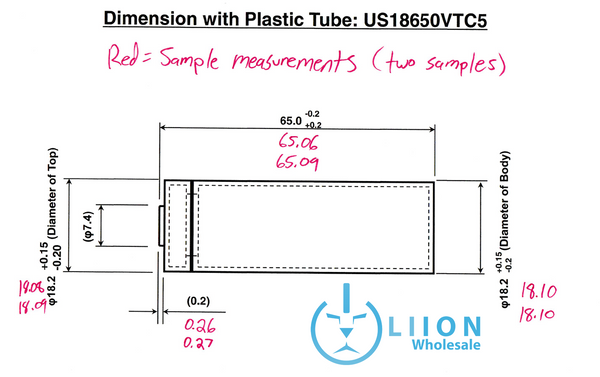
Authentic Sony VTC markings
The genuine Sony VTC5 has a few markings on it. Check the Sony VTC5 specification here for more detail.

Here is a detailed list of those physical things to check for.
- A green PVC wrapper with just a QR code printed on it. The wrapper is a fairly dark green. It appears to have markings but other than the QR code those are actually on the bare metal tube underneath and show through the wrapper. If yours has the text markings printed onto the wrapper it's a fake.
- Result: Pass We peeled off the wrapper and sure enough these markings are on the tube as shown.
- A QR code. Despite what other outdated guides may say these QR codes can vary slightly based on the printing equipment at that plant and beyond seeing that it is present there's not a good way to verify anything here. Also, the spec merely says that it has to be on the surface of the tube, no mention of location. Some people see pictures online of legitimate ones and assume the QR code has to be in a certain alignment but it's not, because it is printed on the PVC covering itself and is put on by a machine over the cell, so it could be in alignment with the text or not.
- Result: Pass QR code present
- An RU symbol to show UL certification. The spec again calls out that this can be anywhere but it shows it with the top between the two lines of text and every genuine VTC5 we've seen has it in this spot - where the top is around the middle of the text block and the bottom is below the text block, and it's to the right of the text.
- Result: Pass
- 2 lines of text. This text is coded and tells you information about which plant it was manufactured in, which specification (VTC4, VTC5, etc), the manufacture date, and an electrode designation.
- Result: Pass More information on this below.
- A seam. Due to the wrapping process on these there's a fairly pronounced seam. Some customers have asked about the seam because of this sun-vapers article but if you read in the comments below it he says that the seam is very noticeable in person but doesn't look as noticeable in the picture as it is in real life on the authentic one. I have seen ones like the fake in that article and the seam is clearly very bad on it. In an authentic the seam is definitely noticeable but at the same time is fairly straight and is not a clearly low quality seam.
- Result: Pass
- The top (positive) cap is attached at 3 points in a relatively distinctive pattern. LG cells for example have 4 attachment points. The safety separator ring is black.
- Result: Pass
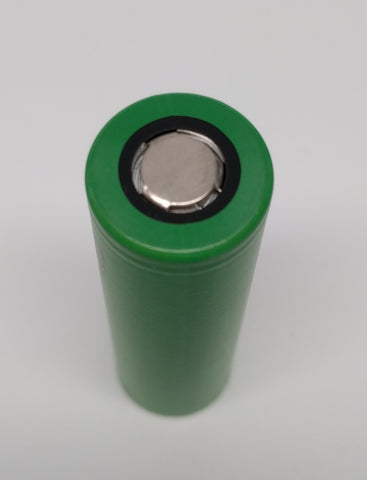
- The bottom negative cap is flat, no protrusion or markings. Note this one is true for both the VTC4 and VTC5, but not the VTC3.
- Result: Pass
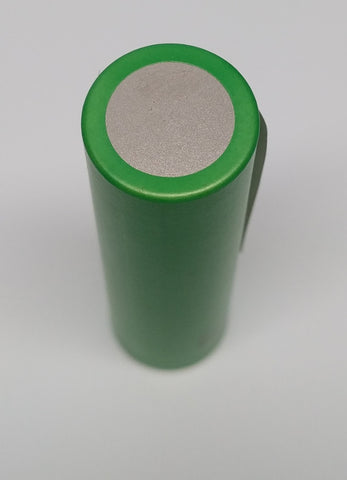
- No other markings other than the ones mentioned above are found on the cell. Many other cells have random hidden markings under the PVC, or manufacturing codes on the negative. These don't.
- Result: Pass
VTC5 text decrypting
What do the two lines of text mean? Let's refer to the handy specification. Here's the relevant page:
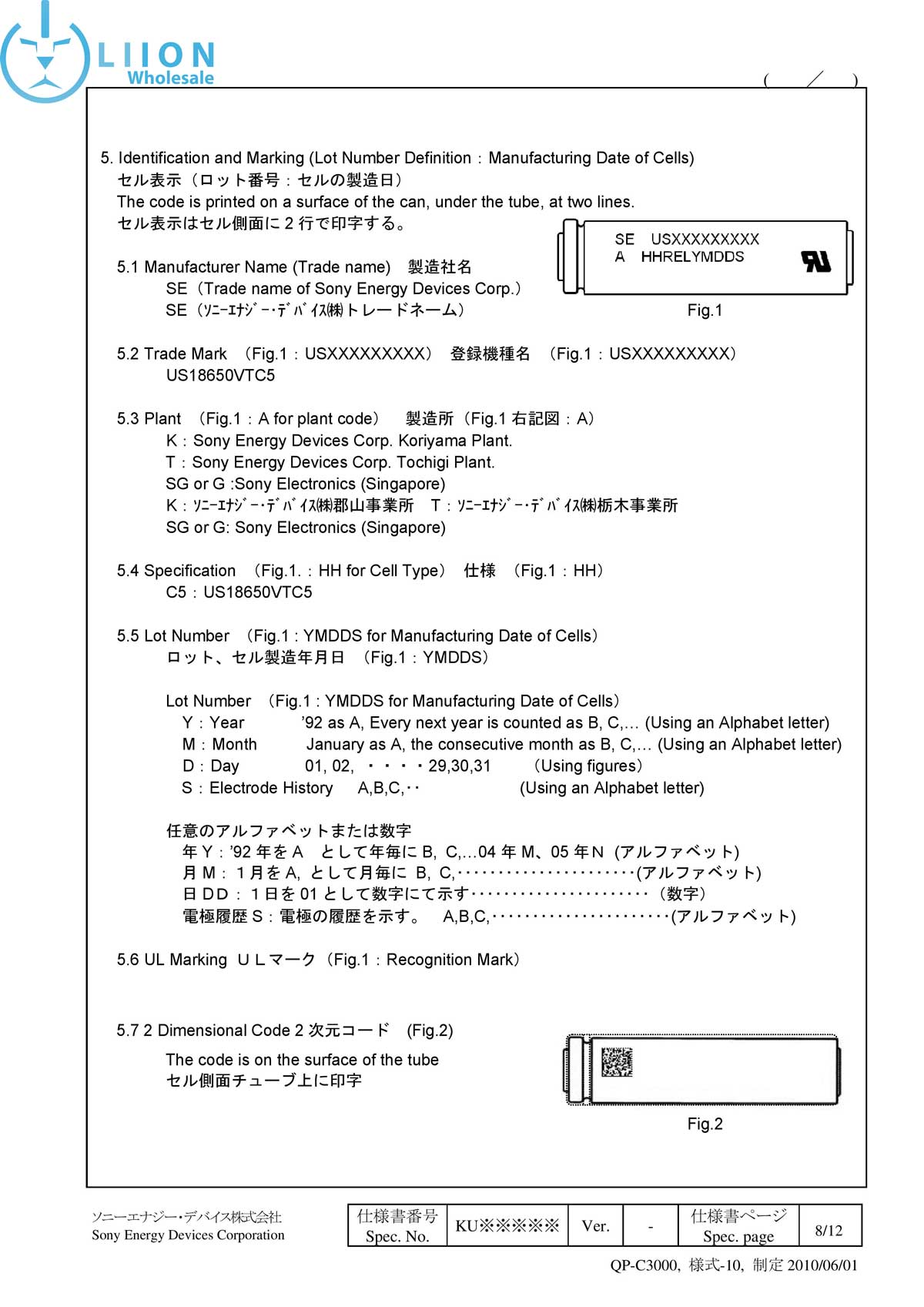
So for example, one of ours reads:
SE US18650VTC5
K C5A1XXD05X
So going in order from left to right:
Line 1:
- SE means Sony Energy, and matches the spec
- US18650VTC5 is the model number, showing that this is the VTC5 model
Line 2:
- K means it was manufactured in the Sony Energy Devices Koriyama Plant, in Japan
- C5 means it's the VTC5 model
- A1X is an internal 3 digit REL code
- X is the year - A is 1992, B is 1993, counting to X gives 2015 as the year of manufacture
- D is the month - similar to above it's the 4th month, or April
- 05 is the day of manufacture, so combined with the above the full date of manufacture is April 5, 2015
- X is another internal code having to do with the electrode history
All of these should be checked to make sure the right number of digits are there, and that the decoding of them makes sense (for example if we had gotten a 2016 date code that would be suspect).
Also, as additional evidence, the other sample battery does have different codes on it. They were bought about 2 months later and sure enough the codes are a later date, July 1st 2015. A counterfeiter probably would not go to the trouble of changing the codes very often if at all.
Unwrapped
Here it is with the wrapper off. You can see the grooves/rings more clearly (the top one is deeper, the bottom is just where the top joins with the bottom so it's a shallow groove) and the QR code is no longer there but the rest of the markings are. No other markings are present.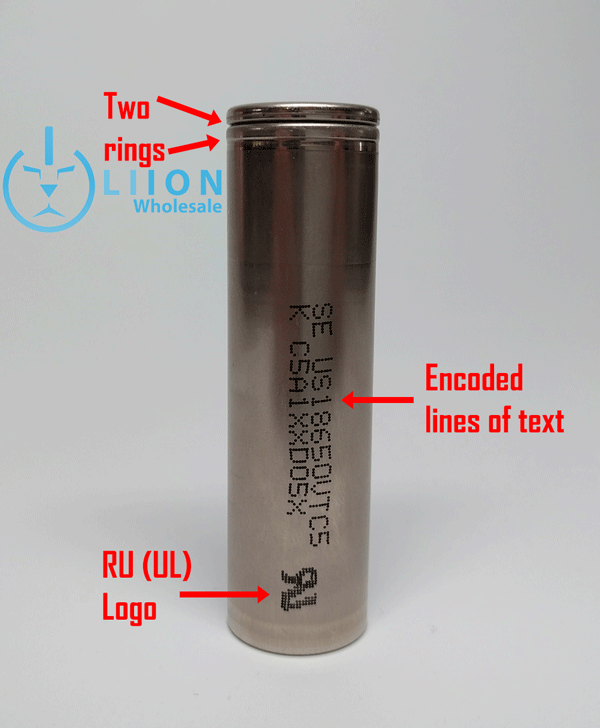
Physical Inspection Summary
Our cells pass physical inspection and match all the specifications for VTC5's.
Test Results
A successful physical inspection is great and all, but we have seen some fake ones that look scarily close to real ones. What really matters is the performance, so now we'll go out to the lab and run some electrical tests.
Here are the continuous discharge curves on the official Sony presentation:
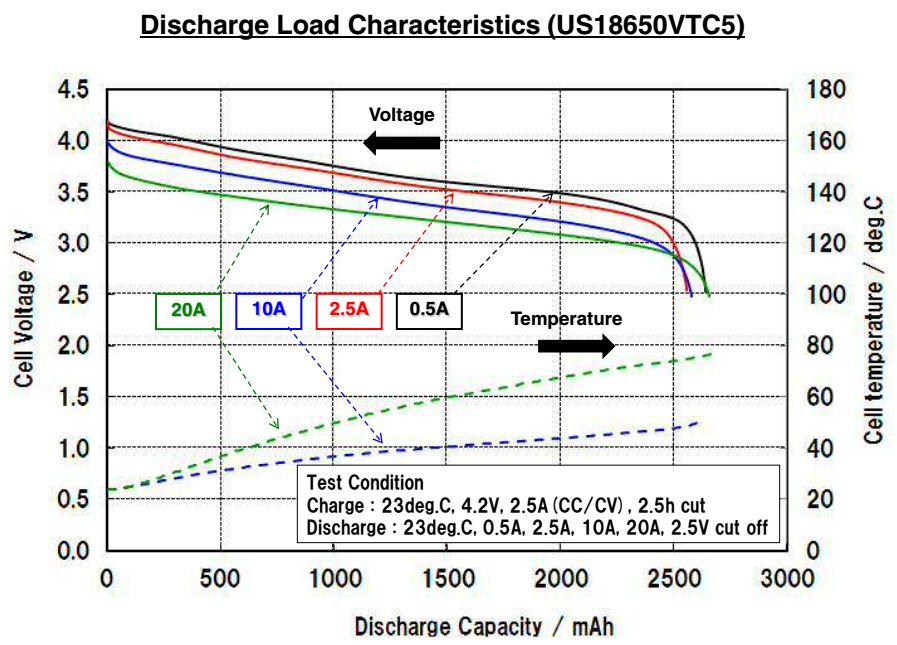
And here is our data on these batteries:
First we'll look at the 2.5A line. You can see the exact same trend and curve shape. Our lines are just a hair (basically negligible) lower in voltage and final mAh but you can see from the following chart that there is a high temperature dependance. Our curves were done at about 14-15 degrees C ambient temperature, whereas the official ones were at 23 degrees C. This chart is from the official Sony vtc5 data presentation.
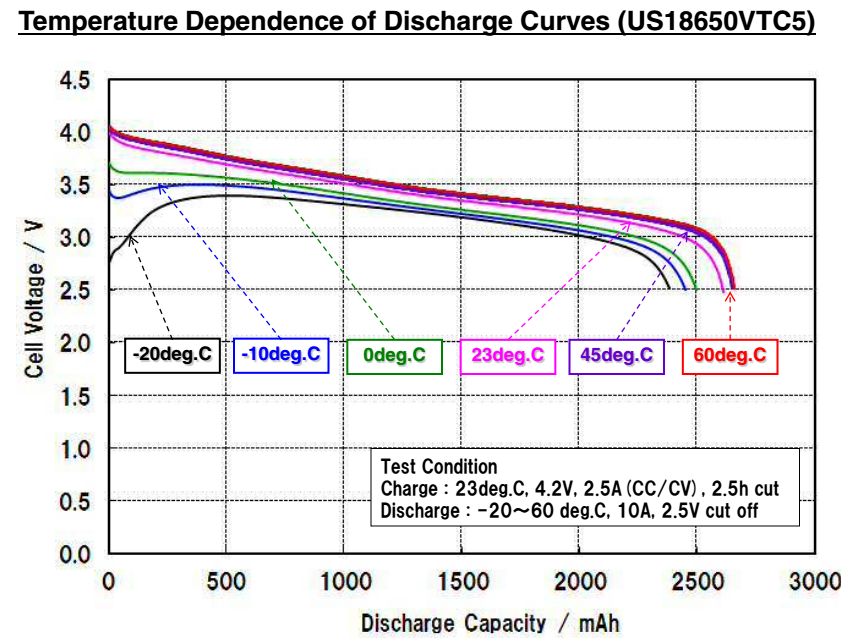
You can see that somewhere between the 0 degree line and the 23 degree line (since we're at 14 degrees C) matches very well with our charts.
The most important of course is the 20A data. Despite how they're sometimes advertised on some websites, these are 20A maximum continuous discharge batteries if no temperature cutoff circuitry is on the pack (most hobbyists using loose cells will not have this circuitry). You can see near identical behavior in the two charts. Again just a negligible amount worse than the official charts but this is likely due to the lower temperature being tested at.
The 10A line and 0.5A lines are as expected as well.
Another thing to note is that the temperatures reached by the cell are the same or lower than the ones reached in the Sony presentation. Obviously a lower quality cell would get hotter when running at the same high current loads. You can see very similar trends here although at 20A it is significantly cooler in our tests. This is partially because of the lower ambient temperatures and also partially because our equipment runs a small fan so the air is not perfectly still around the battery (almost but not quite), which can actually affect it a bit when it's at higher temperatures and heat transfer to the surrounding air becomes more of a factor.
A few other proprietary tests were done to further stress the cell and they handled it like only any top tier battery with ridiculous amounts of dollars worth of R&D can (sorry no detail on this one, we have to keep some secrets around here...)
Summary/Conclusions
All tests passed, these are genuine VTC5's. You can see from the comprehensive spec review on the physical characteristics, and then the test results.
If there's any doubt that we've posted genuine test results, you can also see the blog of "Mooch". This is the screen name of an engineer who has great equipment and specializes in independent battery testing. We had him independently test our VTC5's and he got similar results, here's a link: Mooch's blog review of VTC5's from Liion Wholesale
As a final note, these are great batteries but so are the Samsung 25R which is a very similar quality and rating of battery. If you are at all uneasy about these due to the rumors, even after seeing all this testing, then just go ahead and buy our genuine 25R batteries.
So... why is there all the info on the internet saying the VTC5 doesn't exist?
Sony is very tight lipped about these batteries since they do not want consumers to get their hands on them due to company policy mostly because of liability issues. When they say they are "unavailable in a loose format" it means they don't authorize them to be sold in a loose format, i.e. it is impossible to be an authorized reseller of these particular Sony batteries. The only way to get them is by buying from the OEMs making packs and this requires immense buying power or trusting a wholesaler who says they have that immense buying power to sell you the real thing. That means it's extremely important to get them from a company with a good reputation that can do in-depth testing because otherwise they could have genuine ones one day and fake ones the next.
Hopefully that clears up any confusion, thanks for reading!
- 9 comments
- Tags: Test Results, VTC5
9 comments


Hi Rob, the letter you are posting does not say that. Yes, Sony does not intend them for individual sale, but that does not mean they are fake. All our Sony VTC batteries are authentic.
For everyone else that has seen some inconsistencies, this article is now out of date as Sony has changed their numbering scheme. We’ll release an updated article soon.
This post is not accurate since SONY does not sell VTC batteries as a stand alone product. ALL VTC batteries are fake per Sony’s own legal counsel.
https://imgur.com/a/kSbnt
Mike, my 2nd line is similar…
G 0838134YG11N
Just like you said, mine seem legit otherwise. Bought mine from a local B&M in Raleigh in November, 2016.
The 2nd line on my vtc5 reads nothing like the diagram shown. Here is what I show: G 0975862YC20j. Everything else seems legit.
Sony isn’t discontinuing the VTC5 batteries. After doing some research I found out that production had slowed down after their one of their factories was damaged due to the tsunami/earthquake back in 2011. It just took awhile for us to see the impact.